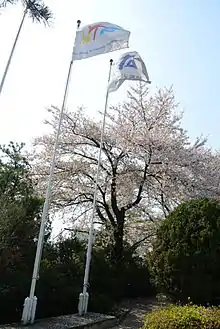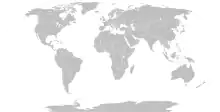Korea Taekwondo Association
Korea Taekwondo Association (한국 태권도 협회; 韓國 跆拳道 協會; KTA), originally the Korea Tang Soo Do Association (1961),[1] is the first taekwondo organisation. It was founded in 1959,[1][2][3][4][5][6][7][8][a] although official South Korean sources give 1961 as its year of establishment.[9][10][b] In 1966, some members of the KTA, led by H. H. Choi, broke off from the KTA and formed the International Taekwon-Do Federation (ITF). The Kukkiwon and the then-World Taekwondo Federation (WTF, now known as World Taekwondo [WT]) were created by the KTA in the early 1970s. The KTA sits under the Korea Sports Council,[11] is aligned with Kukkiwon, and is a Member National Association (MNA) of the WT.[12] Its goal is to promote the martial art taekwondo as a national sport within South Korea.[13]
 The Korea Taekwondo Association is based in Olympic Park, Seoul, South Korea | |
| Abbreviation | KTA |
|---|---|
| Formation | 1959 |
| Type | Government Organisation |
| Purpose | Sport |
| Headquarters | Olympic Park |
| Location |
|
Region served | South Korea |
Official language | Korean |
President | Joon Pyo Hong |
Parent organization | Korea Sports Council |
| Website | www.koreataekwondo.org |
History

The KTA's history has been marked by political difficulties. In 1959, H. H. Choi was the first President of the KTA and Byung Jik Ro (listed as "No" by Park, 1993) and Kae Byung Yun were the inaugural Vice-Presidents.[1] When H. H. Choi was appointed as South Korea's ambassador to Malaysia in 1962, Myung Shin Choi became the second President of the KTA.[2][14] In the early 1960s, the KTA was renamed as the Korea Taesoodo Association, and then to the current form in 1965.[15]
During the 1960s, the KTA assembled the twelve original masters of taekwondo to promote taekwondo throughout the world. Choi headed a demonstration tour of 18 countries in 1965;[16] this was one of many demonstration missions that eventually covered every continent.[17] Choi again became President in 1965, but was forced to resign after a year, reportedly due to his unpopular authoritarian leadership style.[2] He went on to establish the International Taekwon-Do Federation (ITF) the following year. B. J. Ro of the Song Moo Kwan, who had been one of the KTA's inaugural Vice-Presidents, became the fourth President.[2]
In 1967, Yong Chae Kim of the Kang Duk Kwan became the fifth President of the KTA.[2][18] That same year, the KTA created new black belt forms, including Koryo, Keumgang, Taebaek, Pyongwon, Shipjin, Jittae, Cheongkwon, Hansoo, and Ilyo.[19] On 29 January 1971, Un Yong Kim became the sixth President of the KTA,[2] and continued in the position in 1973.[20] The KTA's leadership would remain stable for the next 20 years or so. In 1989, Chong Soo Hong from the Moo Duk Kwan was appointed Vice-President of the KTA.[21]
The early 2000s were a time of trouble for the KTA leadership. One source states that Un Yong Kim resigned from the KTA presidency in 2001,[22] while other sources state that in 1997, Pil Gon Rhee was already in place as President of the KTA.[23][24] In any case, Kim presided over the organisation for around 20 years. In March 2002, Cheon Seo Koo was elected President of the KTA,[25] and apparently held that position until at least 2004,[26] though news sources have reported that he was arrested in late 2003.[27][28]
In early 2008, Jung Gil Kim was President of the KTA.[29] On 11 June 2008, Joon Pyo Hong was elected as the 24th President of the KTA,[29] and he continued in the position in 2009.[30]
Rank promotions
The first official KTA dan promotion test was held on 11 November 1962.[2] The KTA continued awarding dan ranks for several years,[c] but handed over direct dan promotion responsibilities to either the then-WTF in April 1976, according to a Black Belt magazine report,[31] or to Kukkiwon on 5 February 1980, according to historians Won Sik Kang and Kyong Myong Lee.[32] Since then, however, some dan ranks have apparently still been awarded under the authority of the KTA (e.g., S. S. Lee's 9th dan from the Jidokwan, KTA, in 1993).[33]
See also
Notes
a. ^ S. H. Park (1993, p. 248) lists the KTA's founding committee in 1959: "As announced in Dong-A Newspaper; President, Gen. Choi Hong Hi, Vice President, Mr. No Byung Jik, Mr. Yun Kae Byung. Secretary General, Hwang Ki. Standing Directors; Mr. Hyun Jong Myung, Mr. Lee Nam Suk, Mr. Lee Jong Woo, Mr. Ko Jae Chun and Mr. Lee Young Suk. Directors; Mr. Um Un Kyu, Mr. Chong Chang Young, Mr. Bae Young Ki and Mr. Nam Tae Hi. Auditors, Mr. Kim Soon Bae and Mr. Cho Byoung Shi."
b. ^ The claim that the KTA was founded in 1961 might be an attempt to dissociate the organisation from H. H. Choi (its inaugural president) due to later political differences between Choi and the South Korean government.
c. ^ People claiming dan ranks from the KTA include: I. Ahmed, 1st dan (1969), 2nd dan (1970);[34] J. R. Hilland (dan rank and year unspecified);[35] K.-S. Hong, 5th dan (year unspecified);[36] E. A. Humesky, 1st dan (1968), 2nd dan (1970), 3rd dan (1972);[37] C. D. Jung, 7th dan (year unspecified);[38] K. W. Kim, 9th dan (1971);[39] S. Kim, 6th dan (1967), 7th dan (1973), 8th dan (1979);[40] Y. B. Kong, 9th dan (2005);[41] S. S. Lee, 9th dan Jidokwan (1993);[33][42] Y. S. Lee (dan rank and year unspecified);[43] W. C. Park, 4th dan (1963), 5th dan (1966);[44] T. Walsh, 2nd dan (1971);[45] and Y. K. Yoon, 6th dan (1999).[46]
References
- Park, S. H. (1993): About the author. In H. H. Choi: Taekwon-Do: The Korean art of self-defence, 3rd ed. (Vol. 1, pp. 241–274). Mississauga: International Taekwon-Do Federation.
- Kang, W. S., & Lee, K. M. (1999): The modern history of TaeKwonDo Seoul: Bokyung Moonhwasa (ISBN 89-358-0124-0). Retrieved on 6 January 2010.
- Green, T. A. (2001): Martial arts of the world: An encyclopedia (Vol. 1, p. 297). Santa Barbara, CA: ABC-CLIO (ISBN 1-57607-150-2).
- Szumowska, M. (2001): "Through the eyes of the General: The evolution of modern Taekwondo." Black Belt, 39(3):70–75.
- Shaw, S. (2001): The history of the Korean martial arts Archived 2010-01-30 at the Wayback Machine Retrieved on 23 July 2009.
- Jewell, D. (2005): Rhee Taekwon-Do: A history of taekwondo Retrieved on 23 July 2009.
- TKD Timeline Tae Kwon Do Times (January 2010). Retrieved on 25 January 2010.
- Weiler, P. (2006): ITF Deutschland: Geschichte – Teil 4 (German). Retrieved on 25 January 2010.
- Korea Taekwondo Association: History Archived 2013-01-13 at Archive.today Retrieved on 22 July 2009.
- The official website of the Republic of Korea: Taekwondo Retrieved on 23 July 2009.
- Korea Taekwondo Association: Organization Retrieved on 23 July 2009.
- World Taekwondo Federation: Member National Association – Korea Retrieved on 23 July 2009.
- Korea Taekwondo Association: Goal & Function Retrieved on 23 July 2009.
- Hartman, R. (c. 2000): History of Taekwondo: Korea Taekwondo Association Retrieved on 25 January 2010.
- Jagtiani, J. R. (2007): History of taekkwondo: A Korean martial art in modern times The Seoul Times, 2007. Retrieved on 23 July 2009.
- Kim, P. S. (1965): "Korea dispatches Taekwon-Do (Taesoodo) mission." Black Belt, 3(9):53.
- Park, Y. H., Park, Y. H., & Gerrard, J. (1989/1999): Tae Kwon Do: The ultimate reference guide to the world's most popular martial art (Updated edition, p. 5). New York: Checkmark Books (ISBN 0-8160-3839-2).
- Shaw, S. (1989/2004): Taekwondo history Retrieved on 7 January 2010.
- McLain, R. (2009): Master Yoon Byung-in's legacy: The Changmoo-Kwan and Kangduk-Won Archived 2011-07-15 at the Wayback Machine Totally Tae Kwon Do, 5:32–40.
- Anonymous (1973): "Black Belt Times: New Korea Taekwondo center." Black Belt, 11(5):12.
- Chun, R. (1975/2003): Beginning Moo Duk Kwan Tae Kwon Do: Korean art of self-defense (Vol. 1), 27th printing (2003), p. 13. Santa Clarita, CA: Ohara (ISBN 0-89750-015-6).
- Ko Mu Do Kwan: Taekwondo Archived 2010-05-05 at the Wayback Machine Retrieved on 26 January 2010.
- Hong's USA Taekwondo, Habgido, Gumdo, Inc.: Commendations, citations, certificates & citizenship awards Retrieved on 7 January 2010.
- Grandmaster Yong Chin Pak: Plaques Retrieved on 7 January 2010.
- Foreign taekwondo officials call for unity in domestic community (9 April 2002). Retrieved on 18 January 2010.
- Macintyre, D. (2004): Fighting dirty TIME (8 March 2004). Retrieved on 8 January 2010.
- Kim, W.-B., & Lee, S.-K. (2003): 4 detained in taekwondo probe JoongAng Daily (6 December 2003). Retrieved on 25 March 2010.
- BBC News: S Korea Taekwondo chief held (5 December 2003). Retrieved on 25 March 2010.
- Kim, G. (2008): GNP Floor Leader Hong elected as KTA head: Hong Joon-Pyo stresses Taekwondo's advance abroad The Seoul Times (2008). Retrieved on 7 January 2010.
- Kang, S.-W. (2009): Government denies backing WTF candidate The Korea Times (20 September 2009). Retrieved on 8 January 2010.
- Anonymous (1977): "Kukkiwon reveals new Dan test rules." Black Belt, 15(7):71.
- Kang, W. S., & Lee, K. M. (1999): The modern history of taekwondo (Chapter 4, Section 2: Producing elite taekwondo-in). Retrieved on 23 July 2009.
- East Coast Taekwondo Academy: Grand Master Retrieved on 23 July 2009.
- World Martial Arts College: Martial arts biography of Grand Master Dr Ibraham Ahmed Retrieved on 2 January 2010.
- Red River Hapkido: Instructors Retrieved on 23 July 2009.
- World Marshal (sic) Arts Hongmudo Academy Retrieved on 21 December 2009.
- Universal Taekwondo Brotherhood: Professor Eugene A. Humesky Retrieved on 23 July 2009.
- Netherlands Moosoolwon: Master Kim, Je Wook 6th degree black belt Retrieved on 4 January 2010.
- Kim Studio: Grandmaster Kim (2003). Retrieved on 6 May 2010.
- Kim Soo Karate: Awards Retrieved on 23 July 2009.
- Barkousky, L. (2005): Master of self: Grand master says Tae Kwon Do reaches beyond physical skill Pittsburgh Post-Gazette (10 April 2005). Retrieved on 29 January 2010.
- Seven Tigers Taekwondo and Hapkido: Sung Soo Lee Retrieved on 21 December 2009.
- Hawkins, P. (2004): An interview with Grandmaster Lee Yoo Sun Archived 2011-07-15 at the Wayback Machine Totally Tae Kwon Do, 5:9–15.
- Grandmaster Won Chik Park Retrieved on 6 January 2010.
- Walsh Martial Arts Australia: Grandmaster Terence Walsh Retrieved on 20 December 2009.
- YK Martial Arts: Staff Retrieved on 23 July 2009.
External links
- Korea Taekwondo Association (in Korean)
- Korea Taekwondo Association (in English)
- Korea Taekwondo Association (in English) (older version)
- Korea Taekwondo Association Code of Etiquette (1971)
- Korea Taekwondo Association logo
